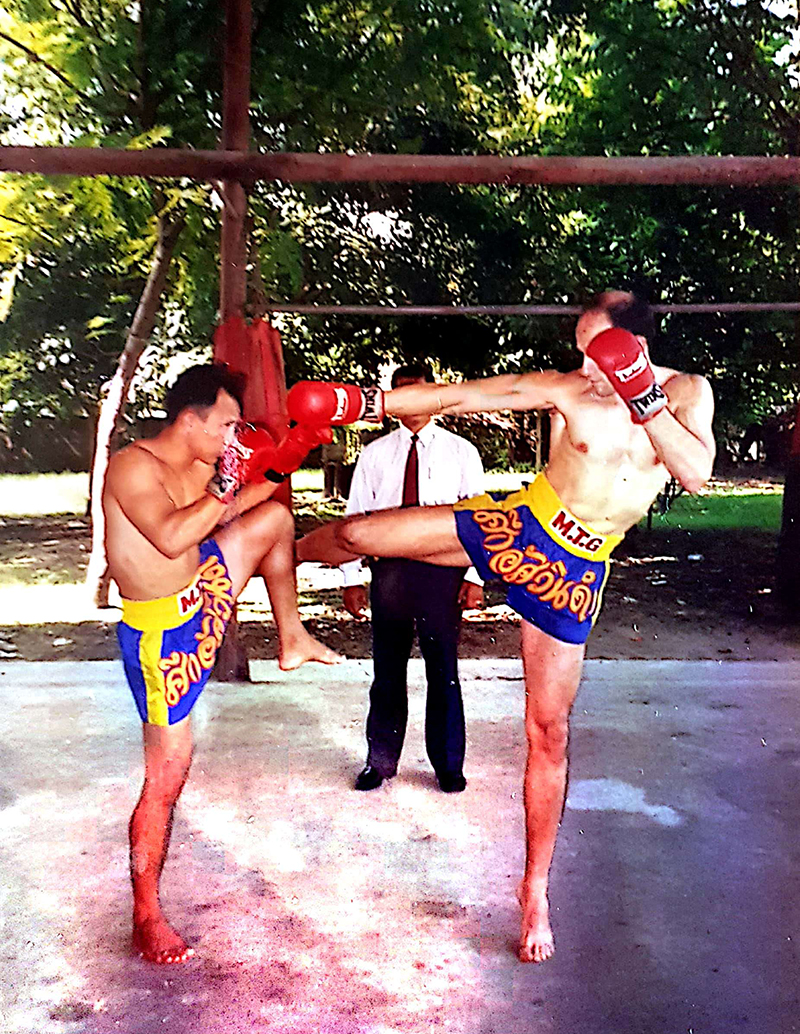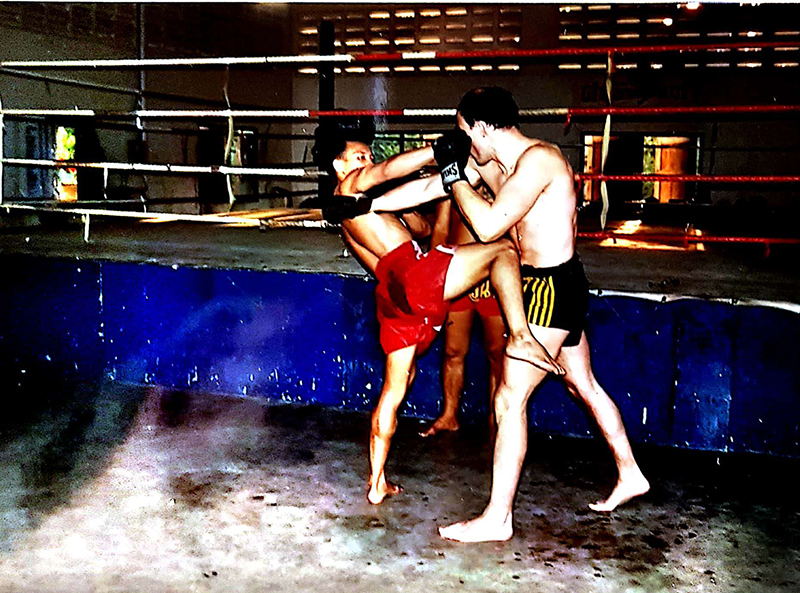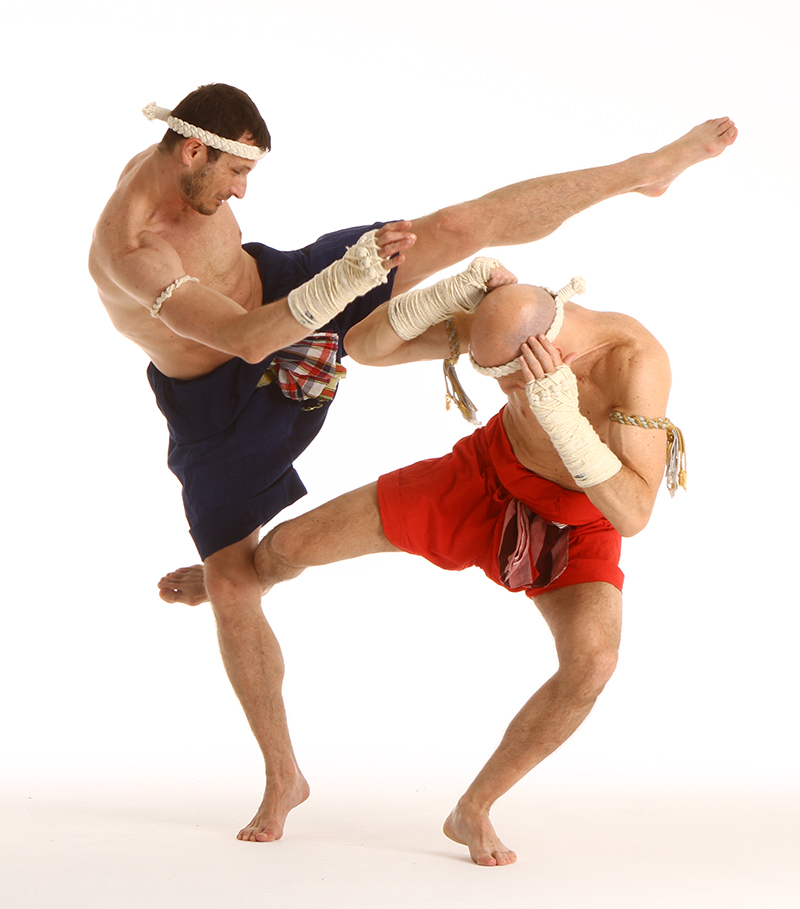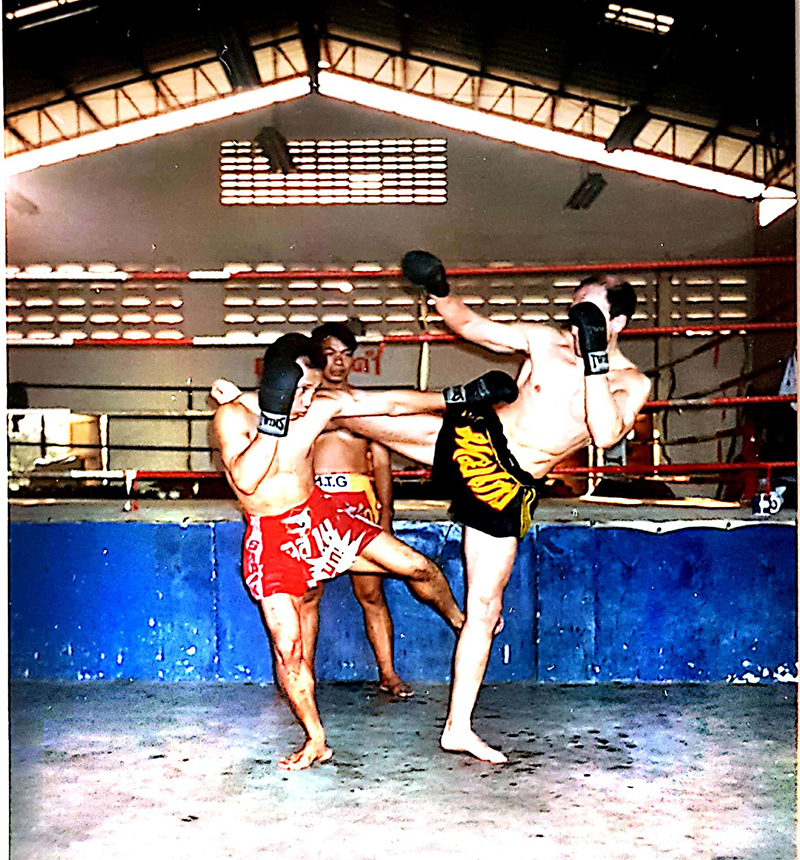
Learning original Muay Thai: the power of team work.
Chapter 2
the Art of counterattack of Boglek Pinsinchai.
By Marco De Cesaris
Rajamnern Muay Thai Stadium, Bangkok. The fighter in the blue corner charges like a raging bull: he knows he is behind on points because he has been floored several times by the fighter in the red corner. However, he doesn’t accept defeat and chooses to relentlessly attack hoping to find a gap in his opponent’s wall of defense. As soon as he sees an opening the blue corner fighter shoots one more powerful roundhouse kick aimed at his opponent’s midsection. However, he realises too late that he is falling again into the Red’s trap. In a blink of an eye, the Red sidesteps, bends down and cut the supporting leg of the Blue with an incredibly fast low kick that heavily takes the attacker down. The thai boxer in the blue corner was courageous and strong but the fighter he was facing was too skilled for him. Actually, too good for most of his opponents. In fact, the boxer in the red shorts was one of the best Muay Thai counter fighters of all times, pound for pound: his ring name is Boglek Pinsinchai.
Boglek’ record speaks for itself:
170 official fights
162 wins
8 losses
0 draws
An incredible 95.29% of wins.
Champion of Thailand 1984
Lumpini Stadium Champion 1986-1987
Weight: 112 lbs (51 kgs) to 119 lbs (54 kgs).
During my stays at Pinsinchai Gym, I was so lucky to have him many times as a senior tutor, always under the watchful eye of Master Krutsuwan. At the time, Boglek was a renowned champion an elite fighter member of the Asswindum, the association of Rajadamnern Boxing Stadium’s top promoters.
He was respected by all fighters at General Pinshinchai’s Camp. He was one of the Seniors and everybody wanted to learn his tricks and fighting strategies. His face didn’t carry any remainders of the many fights he had been through. In fact, he perfectly embodied the definitive Muay Thai counter fighter. His countering skills were exceptional, as well as his excellent fighting tactics. His defense and counters against roundhouse kicks were legendary. Without any doubt, his favourite technique, the one that made him famous, was his incredible cut kick. This fighting strategy is very ancient: in Muay Boran it is called “the monk sweeps the floor” or Then Kwad Laan.
This traditional technique belongs to the so called Kon Muay Kae style (see previous articles:The elusive Art of counter fighting: Kon Muay Kae style (part 2)). A fighter well trained in Kon Kae style possesses an arsenal of counter fighting maneuvers that allow him to cope with a lot of possible attacks: punches, kicks, knee strikes and elbow strikes. Some of the best exponents of modern Muay are counter fighters. They belong to a tradition of warriors that in ancient times displayed the most beautiful yet destructive version of Siamese fighting. In a modern Muay Thai fight most scoring attacks are represented by kicks: among the various styles of kicking, swing kicks to the midsection are more often employed because of the high scores they guarantee. Therefore, it is very wise for a Nak Muay (Muay fighter) to develop more than one fighting tactic to cope with those power roundhouse shin kicks. Boglek Pinsinchai was an absolute master in spotting, evading and countering roundhouse kicks in many effective ways. He taught me the subtle art of luring the opponent, leading him to attack you exactly with the technique you are prepared to counter. This tactic is called Lo in Thai language. For example, he showed me many ways to induce the opponent to kick your flank by sidestepping or by faking to open your guard. When the opponent falls into your trap and kicks you, you must retaliate immediately, before the attack is completed. It is clear that you must have good reflexes and good leg speed to do that but with a good teacher and with the right training everybody can improve his performance. The scenarios he worked on were usually the following:
1. You kick the opponent with your rear leg and let him counter with his power shin kick that you check with both of your arms. Then you kick him again and at the same time as he counter strikes, you take a short step to the side and kick his supporting leg’s knee. He will surely fall down, heavily.
2. You sidestep a few times away from his open side (the side of his back leg). Then you suddenly stop and lure him to unleash the power of his back leg roundhouse kick. Since this is your trap, you are well prepared to quickly sidestep and kick his supporting leg’s knee, heavily flooring your opponent.
3. You kick the opponent midsection with a fast kick, without putting your body mass into the kick. As a consequence, you’ll find yourself in a perfect balanced position, ready to take a short step to the side and catch his retaliatory kick under your armpit. You now have 3 options:
I. option number one you kick the front of his knee to hurt the joint and double your first strike with a kick to the neck or side of the head.
II. Option number 2: you punch the face and then you kick the supporting leg.
III. Option number 3: after catching his leg you proceed to kick the back of his supporting leg’s knee to throw the opponent right away.
Boglek Pinsinchai’s outsanding counterfighting skill was not limited to long range fighting. At middle range he used to nail his opponents with stinging punches, straight or short hooks. Although not properly a puncher, nevertheless he kept his opponents continuously guessing what body weapon he was planning to use both at long and medium range. Even at grappling range, Boglek was still an incredibly good counter fighter. In fact, he was seldom the first one to engage in clinch work, as soon as his opponent tried to catch hold of his neck or arms, he swiftly switched to grappling mode. He usually waited for the opponent to make his move and then in a flash, he broke his balance with a quick body twist. Most of the times the attacker had no time to start unleashing his knee strikes and fell hard on the mat.
His training system.
Many have tried to understand the “secret” of Boglek Pinsinchai’s unbeatable cut kick. There is no secret, actually. The problem is not how you execute the low kick: after many repetitions and regular heavy bag work everybody can do it. The real question is how to develop the timing to actually apply that kick at the right moment in a fight. In fact, the opponent is not going to stand still, nor he will gladly accept to attack you with the technique you expect when you need it. The best system to develop good sense of timing is through long sessions of Len Chern (pre-arranged sparring).
This is what Boglek did on a daily basis with some of the best fighters of his time. There is no secret, just strong will power and correct training methods. Since life at the Camp can be very boring (training 8hours a day, 6 days a week is a real hard work for everybody) boxers at Pinsnchai Gim always tried to find original ways to amuse them while training. One of the “games” I witnessed often was trying to take Boglek down while working Len Chern. Him and his fellow fighters wore shin guards and bag gloves, stepped into the ring and started to throw kicks to the legs, body and head. One after the other they all tried their best to score on him (mostly unsuccessfully) while he blocked or evaded their attacks and ineluctably took each one of them down with one of his famed cut kicks. He surely possessed quick reflexes and an innate sense of timing; nonetheless, he spent hours refining his skill with the humbleness of a true champion.




